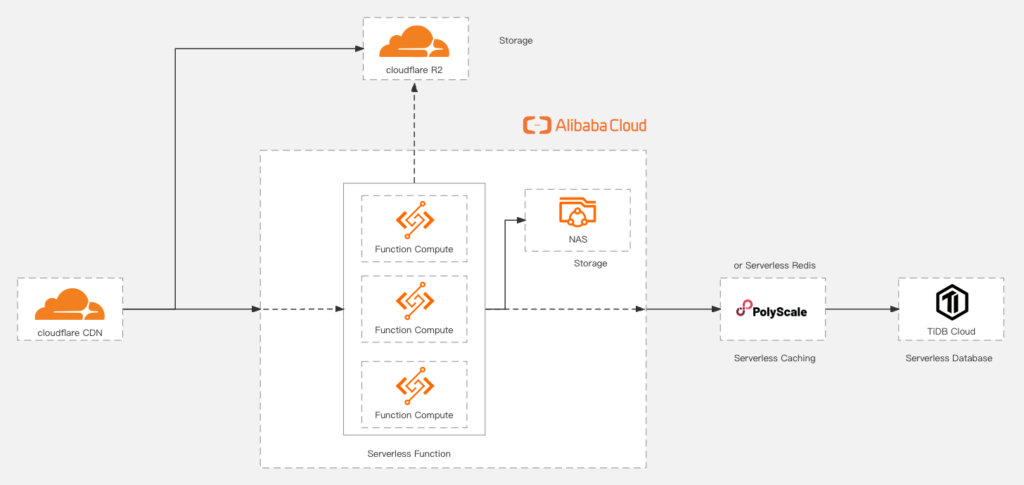More than 40% of websites worldwide are created using WordPress. When people choose to create a website with WordPress, they typically opt for shared hosting, VPS, or cloud servers. The differences among these three lie in:
- Shared hosting involves deploying multiple websites on a single host.
- VPS utilizes virtualization technology to deploy multiple websites on a single host.
- Cloud servers use virtual technology to deploy a single website across multiple hosts.
Due to varying degrees of overselling, the price hierarchy is shared hosting < VPS < cloud servers.
In recent years, with the development of cloud computing, a new website hosting method has emerged: Full-Stack Serverless. This includes Serverless Function, Serverless Database, and Serverless Cache. Websites deployed using Full-Stack Serverless are not only cheaper than shared hosting but also offer the same availability as cloud servers. This is due to request-based billing and the ability to scale down to zero.
Why is Full-Stack Serverless even cheaper than shared hosting?
Shared hosting providers like Hostinger and Siteground offer prices as low as $2.9 per month for the first year (though renewal costs double in the second year). So, why would Full-Stack Serverless be even more economical? Taking Serverless Function as an example, providers like Alibaba Cloud Function Compute, AWS Lambda, and GCP Cloud Function follow a pricing model based on the number of calls and actual resource consumption per call. This means users incur costs only when the function is invoked, resulting in no expenses when there are no requests.
Let’s look at the deployment architecture diagram for Full-Stack Serverless:

The diagram includes five cloud products, each with the following prices:
- Alibaba Cloud Function Compute (used for deploying WordPress): New users get the first three months with 1 million free calls. Beyond the limit, assuming a 0.2-core 512MB instance (sufficient for WordPress) with 10,000 calls per day, the monthly cost is around $0.6 (calculated based on a 500-millisecond per request cost; optimization could make it even cheaper).
- Alibaba Cloud NAS (providing storage for themes and plugins, while media files are stored on Cloudflare R2): 1GB costs approximately $0.3 per month.
- TiDB Serverless: Offers 50 million free RU and 5GB storage per month. Beyond the limit, it costs $0.1 per million RU and $0.2 per GB of storage. Additional optimization using PolyScale can reduce RU consumption.
- PolyScale (database cache): Includes 10 million free calls per month, with a cost of $0.4 per million calls beyond the limit.
- CloudFlare (providing CDN, DNS, object storage, security, and HTTPS services): All products have free quotas sufficient for WordPress users. Media files can be stored on Cloudflare R2.
Therefore, with the above combination of products, the cost of hosting a WordPress site is minimal unless the site experiences high traffic, such as over 100,000 monthly visits. Assuming 10,000 function calls per day, the monthly cost is only about $0.6.
Is Full-Stack Serverless only more cheaper?
When choosing shared hosting, considerations often involve a website’s initial stages and low traffic. With Full-Stack Serverless, the automatic scaling capability eliminates concerns about migrating your WordPress site as it grows. From functions to databases and storage, everything can automatically scale, providing abundant infrastructure resources.
Why adopt Serverless WordPress now?
The emphasis in this article on Full-Stack Serverless is key. Only with Full-Stack can the cost of low-traffic websites be minimized. Previously, if you wanted to deploy WordPress in a Serverless architecture, the available options were Functions and RDS. However, RDS was expensive due to fixed costs, even when the site received no visits. Serverless Databases with request-based billing, such as TiDB Serverless and Neon, truly enable on-demand payments.
Conclusion
If you are still considering shared hosting for your WordPress site, I strongly recommend trying Full-Stack Serverless. Your website is deployed in your own cloud account, and you no longer have to worry about the hassle of server migrations due to increased traffic or the frustration of doubled subscription prices during renewal.
Latest news: We have abandoned the full-stack serverless WordPress. You can see why here.